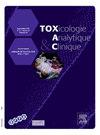Usefulness of microsampling devices in pharmacology and toxicology
IF 1.8
Q4 TOXICOLOGY
引用次数: 0
Abstract
Microsampling devices, such as dried blood spot (DBS) cards, offer significant advantages such as easy collection and low sample volume. However, their use poses challenges, including the effect of blood volume on analyses and the risk of contamination. The analytical validation of these methods requires a thorough evaluation of specific parameters, which can increase the number of required analyses compared to conventional methods. In the field of therapeutic drug monitoring, microsampling methods like DBS facilitate the collection of valuable information on drug interactions and patient metabolic capacities, thereby enhancing therapy efficacy and safety. Similarly, toxicological screening techniques benefit from the advantages of microsampling for faster and more comprehensive analysis. DBS analysis for doping detection offers advantages such as rapid and minimally invasive sample collection, as well as analyte stability at room temperature. However, it is subject to constraints related to sample preparation and volume. Recent advances in DBS technology have improved the detection and quantification of a wide range of drugs and psychoactive substances in clinical and forensic toxicology, offering more effective and stable methods despite some limitations related to sample collection and analysis. Finally, the application of DBS technology to environmental analysis enables the measurement of chemical concentration or presence in the human body, providing valuable information for assessing environmental exposures and contributing to the prevention of environmental health risks, particularly concerning trace elements, organic chemicals, and environmental exposure biomarkers such as tobacco smoke.
微采样装置在药理学和毒理学中的应用
微采样设备,如干血斑(DBS)卡,具有易于收集和低样本量等显著优点。然而,它们的使用带来了挑战,包括血容量对分析的影响和污染的风险。这些方法的分析验证需要对特定参数进行彻底的评估,与传统方法相比,这可能会增加所需分析的数量。在治疗药物监测领域,DBS等微采样方法有助于收集有关药物相互作用和患者代谢能力的宝贵信息,从而提高治疗疗效和安全性。同样,毒理学筛选技术得益于微采样的优势,可以更快、更全面地进行分析。DBS分析用于兴奋剂检测具有快速和微创的样品采集以及分析物在室温下的稳定性等优点。然而,它受到与样品制备和体积有关的限制。DBS技术的最新进展改善了临床和法医毒理学中各种药物和精神活性物质的检测和定量,尽管在样本收集和分析方面存在一些限制,但提供了更有效和稳定的方法。最后,将DBS技术应用于环境分析,可以测量化学物质在人体内的浓度或存在,为评估环境暴露提供有价值的信息,并有助于预防环境健康风险,特别是有关微量元素、有机化学品和烟草烟雾等环境暴露生物标志物的风险。
本文章由计算机程序翻译,如有差异,请以英文原文为准。
求助全文
约1分钟内获得全文
求助全文

 求助内容:
求助内容: 应助结果提醒方式:
应助结果提醒方式:


